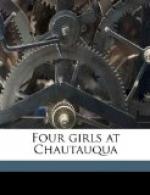Now how did those four girls come to be friends? Oh, dreadful! You don’t expect me to be able to account for human friendships I hope, especially for school-girl friendships? There is no known rule that will apply to such idiosyncracies. They had been in school together, oven Marion Wilbur, with the indomitable energy which characterized her, had managed one term of Madame La Fonte’s enormous bills, and with the close of the term found herself strangely enough drawn into this strange medley of character that moved in such different circles, and yet called themselves friends. You are to understand that though the same church received these girls on Sunday, yet the actual circle in which their lives whirled was as unlike as possible. The Erskines were the cream, cultured, traveled, wealthy, aristocratic as to blood and as to manners, literary in the sense that they bought rare books, and knew why they were rare. The Mitchells had a calling acquaintance with their family because Dr. Mitchell was their chosen physician, but that came to pass through an accident, and not many of the doctor’s patrons were of just the same stamp. This family never went to the Erskine entertainments, never were invited to go to the other entertainments starting from the same circle, yet they had their friends and many of them. The Shipleys were free-and-easy, cordial, social, friendly people, who bought many books and pictures, and were prominent in fairs and festivals, and were popular everywhere, but were not, after all, of the Erskine stamp. Finally came Marion, alone, no position any where, save as she ruled in the most difficult room in the most difficult ward in the city. A worker, known to be such; a manager, recognized as one who could make incongruous elements meet and marshal into working order. In that capacity she found her place even in the First Church, for they had fairs and festivals, and oyster suppers, and other trials even in the First Church; and there was much work to be done, and Marion Wilbur could work.
And these four girls were going to Chautauqua—were to start on Monday morning, August 2, 1875.
CHAPTER II.
The question discussed.
Rev. Dr. Dennis and Rev. Mr. Harrison met just at the corner of Howard and Clinton Streets, and stopped for a chat. Dr. Dennis was pastor of the First Church, and Mr. Harrison was pastor of the Fourth, and some of the sheep belonging to these respective flocks supposed the two churches to be rivals, but the pastors thereof never thought of such a thing. On the contrary, they were always getting up excuses for coming in contact with each other; and woe to the work that was waiting for each when they chanced to meet of a morning on some shady corner.
“You are to be represented, I hear, at the coming assembly,” said Mr. Harrison, as they shook hands in that hearty way which says, as plainly as words, “How very glad I am to see you!”




